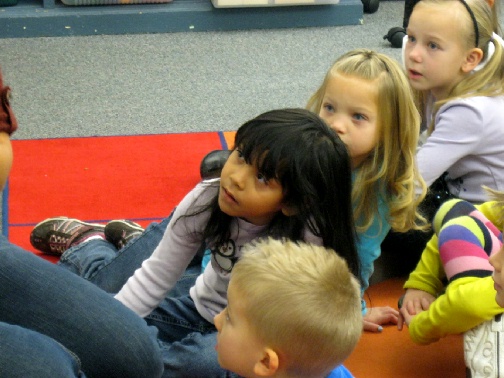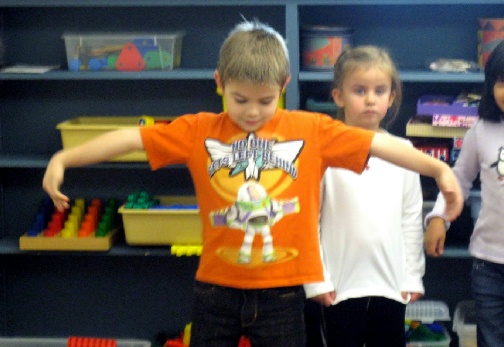ArtsBridge: Building confidence and creativity, one year at a time
December 16th, 2011 Posted in Arts and LifeStory and photos by Allee Evensen
CACHE VALLEY — JaDene Denniston is an educator, an award-winning media specialist, a cook and a seamstress. However, there is one title cares for more than any of the others: She prefers to be called artist. As she sits at the checkout desk at Mountainside Elementary in the small town of Mendon, Utah, her hands constantly stay busy sending out emails, loaning media materials to teachers and taking care the library’s parakeet, who students call, “the famous bird.”
“She’ll say ‘read a book’,” says Denniston, touching the bird’s wire cage. “It’s just another element of bringing real life into what’s here. It’s trying to make a library a living organism.” 
It might surprise some to learn that Denniston wasn’t always the reader she is today. Her story is one that is familiar to the 20 percent of students across the nation who have a learning disability. As a child she was diagnosed with dyslexia, a developmental reading disorder. She struggled with reading until high school, when she realized that she could still learn, just not in the same way her classmates could.
“My art is what saved me,” Denniston said. “It still does.”
She took up painting, drawing, cooking and any other form of art she could get her hands on to help her learn concepts. As time went on, Denniston realized that thousands of students were caught in ruts like hers, unable to learn effectively in the classroom. Last year she used her position at the elementary school to pitch the idea of using ArtsBridge, a program that was already in place at a neighboring schools.
ArtsBridge is program based on the belief that art is a crucial part of the educational process. The program is a national organization that works to confront the problem of art funding being cut in schools around the United States. Since its founding in 1996, it has taken root in 31 universities in 16 different states. Funded by grants and donation money, the program teaches core subjects like literature, math and science in K-12 classrooms using art.
According to data from the College Board, students who take four years of art and music classes have SAT scores averaging more than 100 points higher on the critical reading and math portions than students who take less than a half year of art.
Whether they are born artists or not, Denniston said it is absolutely crucial for young minds to be stimulated through music, literature, and visual arts. She said it was art that kept her coming back to school when other subjects were frustrating.
“I was successful at it,” she said. ”Art was the fun part. It was the part that was creative. It was the part that wasn’t the athlete, that wasn’t the star speller. But when it came to creating and sewing, I was just doing the things I had done my whole life.”
Holly Conger, ArtsBridge director at Utah State University, said the program creates better students and better schools, eventually leading to better communities.
“Different children have different ways of learning,” said Conger. “You can’t expect students to learn the same way, sitting in a desk hearing what the teacher says. Sometimes you have to be standing up and moving in order to process things.”
Starting young
On the surface, Camie Palmer’s kindergarten classroom may seem like any other. In her Wilson Elementary School room colorful posters hang on the walls, hundreds of books line small wooden shelves and a large, bright rug sits in the center of the room. Like most kindergarteners across the country, the 28 students gathered in a circle are learning to read. The differences only become apparent when student-volunteer Cari Johnson hands out wooden drumstick-like instruments and tells the students to tap the sticks together while breaking words into syllables.
 Johnson, a USU student, comes to the class once a week to teach using a program called Reading in Motion. It’s human nature to read to a rhythm, she says, an idea which will help these students learn to read more quickly, and more fluently, than others in their age group.
Johnson, a USU student, comes to the class once a week to teach using a program called Reading in Motion. It’s human nature to read to a rhythm, she says, an idea which will help these students learn to read more quickly, and more fluently, than others in their age group.
“Any time you can teach them through music, I feel that they learn more because it is such a powerful teaching tool,” she said. “It only makes sense to teach reading through music.”
In most other classrooms, learning to read means sitting down with a book and sounding out words, but during this 45-minute class, students hardly sit still for more than a few moments at a time. When they do sit, they pay rapt attention as Johnson goes around the circle one by one, having each student say their syllables out loud to the rest of the class.
“It’s an amazing program,” said Sundee Ware, principal of the school. “They apply the academics, and they make it creative and connect all those brain cells, all those dendrites. It just puts it all together and helps them explore.”
The colligate push
It’s not every day that heavy metal death music is described as delicate and fragile, but when Mauro Diaz talks about his passion for music but uses those exact words. Diaz grew up listening to classic rock and metal music, receiving his first guitar as a Christmas present at age 12. Eight years later, he has hope that his passion will translate into a career, not just a hobby.
The 18-year-old college freshman said that four years ago he wasn’t considering college. He was entering his sophomore year of high school, trying to decide where he fit in. In the month before school started, he decided to enroll in a charter arts school, rather than mainstream public high school. It was here he discovered the high school version of ArtsBridge, a program that helped him record, create, and perform his music.
“I think art, in general, whatever art anybody uses, is a way to express yourself , open a new voice and expand knowledge. Music is my art,” Diaz said.
During his senior year, Diaz was one of six ArtsBridge scholars from his school. The scholars spent their senior year putting together portfolios of their work, planning events based around their art, and spending time on college campuses, the main push of the program.
Conger said all six of the Artsbridge scholars who were once considered “at risk” were accepted into universities. One of the most important aspects of the program, she said, was that the students were integrated into campus life before they were actually students, making the transition less extreme.
“When I was in high school, nobody took me on the college campus and said, ‘These are the fun things we can do in college,’” said Conger. “I looked at college as being this intimidating place in the real world with all of these grownups. These kids are coming up here, and going to concerts and arts shows. They’re doing all this amazing stuff and realizing ‘This isn’t as scary as I thought it was. I think I can do this.’”
By the time he graduated, Diaz had organized and performed in multiple benefit concerts with the help of Todd Milovich, the education outreach coordinator for the Access and Diversity Center at Utah State.
Milovich said the ArtsBridge scholar program helps students find footing in the work force. Humanities, he said, are a basic part of education that teach human beings how to relate to one another — something that can’t be done away with due to budget cuts.
“They are not going to go out and work in any kind of professional field where they’re not going to meet people from every ethnicity,” he said. “It’s so important that people be able to relate to everybody to succeed in the workforce — period.”
On campus
Before taking the position of National Art Education Association president, Robert Sabol was a K-12 art instructor for more than 20 years. Sabol, who is a professor of visual and performing arts at Purdue University, sees art on his campus touching every kind of life, even those who aren’t considered artists.
He said that while cuts in arts funding may not be as apparent on college campuses, they often happen at lower levels in K-12 when administrators are forced into letting go of art teachers, and instead trusting that regular teachers can do the same jobs.
Sabol said art creates a higher order of thinking skills and refinement, critical to those working on a colligate level. He said students in art classes are required to “think out of the box,” which creates a divergent learning experience. The College Board has recognized six areas essential for students to thrive in college, one of them being art.
“Everybody knows that we are bombarded by thousands of images every day,” he said. “Televison, printed media, and textbooks are visual imagery that suggest messages. There is a visual language, and if people don’t understand that, they can be subject to manipulation that might keep them from thinking freely in a democratic society.”
Lisa Abia-Smith, an adjunct associate professor and director of education outreach for the Jordan Schnitzer Museum of Art at University of Oregon, said exposing college students to art is absolutely imperative. A few years ago, Smith saw freshman who were starting to come into college with very weak writing ability. Because of this, she started a Writing for Art class, which she said has made a huge difference in how well the students are performing in writing-based classes.
“We don’t see (college students) understanding culture.” she said. “We’re getting a population of students who aren’t exposed to other cultures, but it doesn’t take a lot to put it back.”
Whether in the clothes we wear, the technology we use, or the advertisments we see on the freeway, Sabol said we live a world immersed in art. Budget cuts can only prevent our learning to understand the art, not the exsistence of art itself, he said.
“Bottom line is the arts do enhance our appreciation of our own life and help us understand who we are as people,” Sabol said.
Back to square one
At the end of the day, Denniston takes little credit for bringing ArtsBridge into her school. As the bell rings and the students clear out, she leans on a library counter and quotes one of her favorite authors: “Disturb the universe and bloom where you’re planted,” she says with a wide smile.
“I have a little teeny tiny part of it. I planted the seed so it would bloom, and the teachers took it and the kids have bloomed where they were planted.”
NW
Tags: ArtsBridge, importance of art, JaDene Denniston, reading, Reading in Motion, teaching math

One Response to “ArtsBridge: Building confidence and creativity, one year at a time”
By Kristen B. on Dec 26, 2011
It is nice to know that students could be able to learn more effectively through arts program. And I am glad that an educator improve a program to reach out to the kids, who also struggle in school. Thanks for sharing this wonderful news.
/Kristen B.
Magnavox MDR515H Reviewer